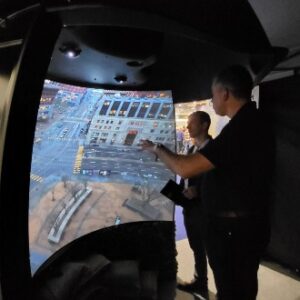Columnist George Tucker meditates on the state of live staging’s past, present and future
“We become what we behold. We shape our tools, and thereafter our tools shape us.” —Marshall McLuhan
Live event work has its share of ebb and flow; overabundant at times or leaving you wondering just who shot the albatross to cause such doldrums at others. Regardless, the essential skills needed vary from technicians to riggers and general hands — a variety of crew were needed. Will the current crisis put an end to it?
The shape of the past
“What if they just put barcodes on the back of our necks? At least we would know where we are and what we were sent for.” A colleague of mine mused over this while the event staging company we worked for was firing on all cylinders. Growing from a small mom-and-pop to a preeminent name in the NYC area was in part due to the dedicated and talented crew. This was a golden era for the company (the first of many) where jobs were often scheduled back to back to back.
Companies like the one I made the move to from recording studios presented a multitude of career paths. Starting out as a shop technician or audio school intern did not limit the direction you could go, all it took was the fortitude to listen and the stamina to keep going. The ability (or the desire to learn how) to perform competently often led to being kept close at hand.
It is a constant quandary for project-based companies whether to invest in keeping a core staff or to rely on freelance talent. There are natural cycles in the industry where companies flow between being in-house labor heavy and outsourcing the lion’s share. The pattern generally follows periods of great growth or entry into a specific market and times of quiet.
During the good times it makes sense locking in talent to consistently complete jobs. While this comes with added weight of salaries and benefits, it does provide an assured pool of talent. When the economics are lean or times when there is steady but flat work, companies tend to wean staff off, often putting the former staff into first-priority freelance roles, with a more nimble cashflow, hopefully, enabling the balance sheets to keep in the black. There may be less work but the work was there.
The shape of the present
The recent crisis has completely turned things around. As of this writing, the prospect of in-person shows is some time in the new year. Audience or no, there is still a need for high production value live entertainment, companywide meetings and product releases. The question is, just what skill sets are needed, and what happens to folks who do not possess them, are their roles gone forever?
Normal shows, from multistage extravaganzas to ballroom corporate events all require several trades working in harmony to bring the experience to life. Lighting operators, riggers, the squad of video village, directors, production, and the FOH bringing all elements together. These crews are needed to run the flotilla of equipment required to produce high quality productions.

As an industry we have been experimenting with edging closer to fully virtual events. More than webinar or Goggle-centric viewing, these events combine live action and immersive elements. The so called XR (Extended Reality) systems translate exceedingly well into remote and network distributed shows. What they do not require are ancillary crew, especially when the event is to be viewed remotely. ‘Virtual’ type shows require highly technical people who understand the nuances of data networks, image mapping, and graphic design.
The pandemic has shown that a fair majority of people can work productively from home. Likewise, the events world is grudgingly acknowledging the same. The ‘shows’ that are continuing use crew who work from home on specialized software via a laptop. The yeoman’s work of multiple trades are needed to a lesser and lesser degree.
The shape of things as they are
Staging and theatrical people value education and training as an essential core component of the culture. We are always learning a new skill, diving deeper into technology or craft with an eye at advancing our capabilities or into more responsibility and new roles. The industry is technology driven, even as we dragged our feet embracing Ethernet and fiber topologies in lieu of reliable stalwarts such as copper. Such an ingrained drive should act as a pathway for displaced hands to move into these new roles, the question is whether they will find their sea legs again.
One only has to take a look at the information technology industry for a clue as to what may be inevitable for event work. If you were accustomed to watching late night cable television in the early aughts the IT training ads were ubiquitous. The promise was that high paying jobs in the world of network computing were in demand and needed trained technicians asap! While the industry was in dire need of able bodies, the true tale is that most wound up being company help desk staff. The jobs were promised as an exciting cutting edge profession where one would help shape the future. In reality the work consisted of helping people recover their passwords (for the twentieth time) or rebooting a computer the user swore they did (they did not).
The current platform for live events just does not support the same number of skilled people to bring it about. Yeah, more technicians will be needed, just not nearly enough to move the majority of idle hands over. We are being shaped by the tools thrust upon the moment. Auxiliary or supporting platforms have now become the de facto method.
The shape of anxiety
Is a great purge upon the industry? Perhaps, at least for now. The best advice is to hold on, keep your skills sharp and look at gaining a better understanding of core technology and niche aspects. From networking and Wi-Fi to audience support services (captioning, assistive listening), being able to jump in when needed can only help.
There is positive movement just over the pond. EU and UK events are slowly starting up using limited audiences, drive-in style attendance and reserved platform viewing pods. It is a hopeful sign that live events focused on a communal gathering will thrive once again, the same, but oh so different, in shape.









